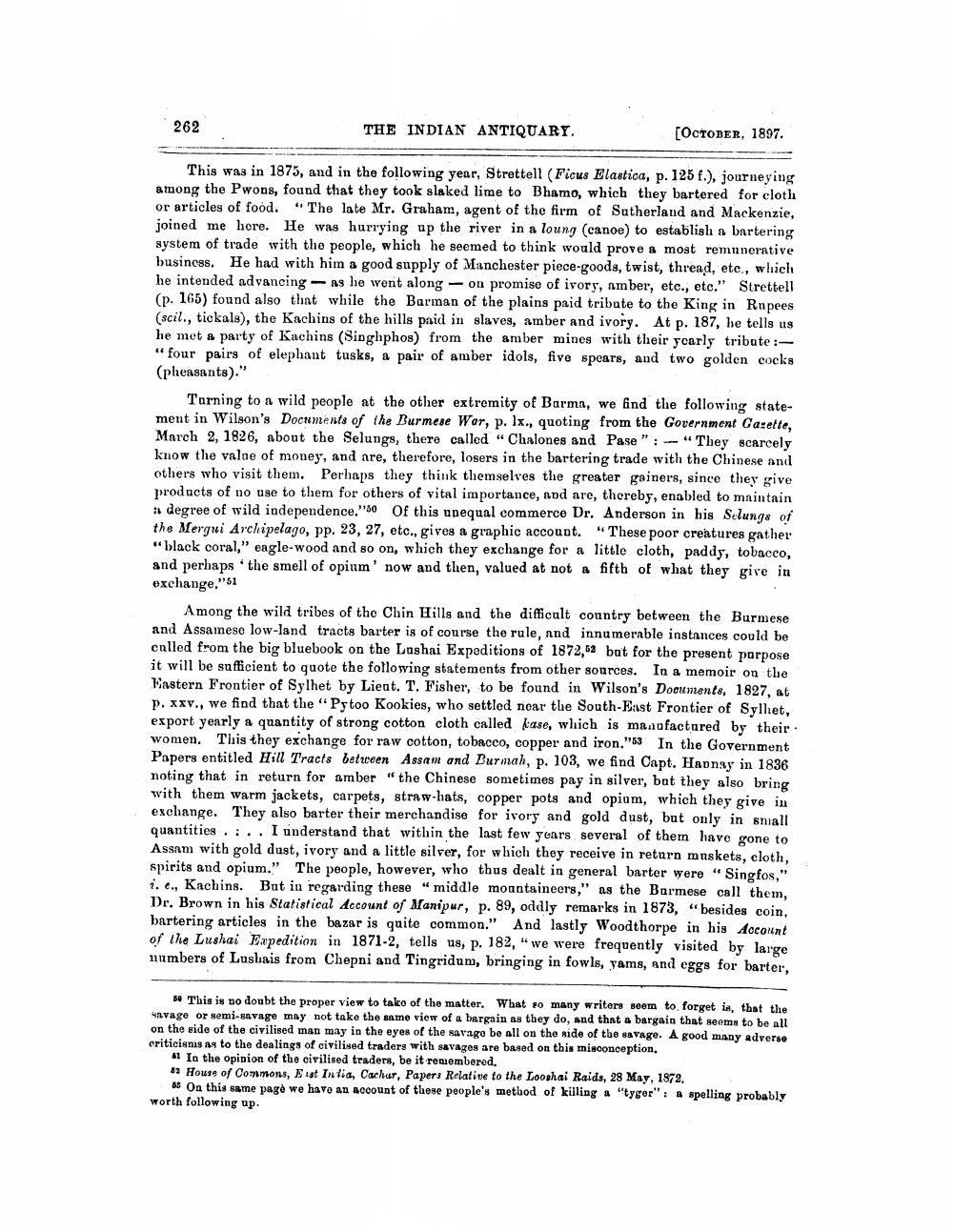________________
262
THE INDIAN ANTIQUARY.
This was in 1875, and in the following year, Strettell (Ficus Elastica, p. 125 f.), journeying among the Pwons, found that they took slaked lime to Bhamo, which they bartered for cloth or articles of food. "The late Mr. Graham, agent of the firm of Sutherland and Mackenzie, joined me here. He was hurrying up the river in a loung (canoe) to establish a bartering system of trade with the people, which he seemed to think would prove a most remunerative business. He had with him a good supply of Manchester piece-goods, twist, thread, etc., which he intended advancing as he went along on promise of ivory, amber, etc., etc." Strettell (p. 165) found also that while the Burman of the plains paid tribute to the King in Rupees (scil., tickals), the Kachins of the hills paid in slaves, amber and ivory. At p. 187, he tells us he met a party of Kachins (Singhphos) from the amber mines with their yearly tribute:"four pairs of elephant tusks, a pair of amber idols, five spears, and two golden cocks (phenats)."
[OCTOBER, 1897.
Turning to a wild people at the other extremity of Barma, we find the following statement in Wilson's Documents of the Burmese War, p. lx., quoting from the Government Gazette, March 2, 1826, about the Selungs, there called "Chalones and Pase":"They scarcely know the value of money, and are, therefore, losers in the bartering trade with the Chinese and others who visit them. Perhaps they think themselves the greater gainers, since they give products of no use to them for others of vital importance, and are, thereby, enabled to maintain a degree of wild independence."50 Of this unequal commerce Dr. Anderson in his Selungs of the Mergui Archipelago, pp. 23, 27, etc., gives a graphic account. "These poor creatures gather "black coral," eagle-wood and so on, which they exchange for a little cloth, paddy, tobacco, and perhaps the smell of opium' now and then, valued at not a fifth of what they give in exchange."51
Among the wild tribes of the Chin Hills and the difficult country between the Burmese and Assamese low-land tracts barter is of course the rule, and innumerable instances could be culled from the big bluebook on the Lashai Expeditions of 1872,52 but for the present purpose it will be sufficient to quote the following statements from other sources. In a memoir on the Eastern Frontier of Sylhet by Lieut. T. Fisher, to be found in Wilson's Documents, 1827, at p. xxv., we find that the "Pytoo Kookies, who settled near the South-East Frontier of Sylhet, export yearly a quantity of strong cotton cloth called kase, which is manufactured by their women. This they exchange for raw cotton, tobacco, copper and iron."53 In the Government Papers entitled Hill Tracts between Assam and Burmah, p. 103, we find Capt. Hannay in 1836 noting that in return for amber "the Chinese sometimes pay in silver, but they also bring with them warm jackets, carpets, straw-hats, copper pots and opium, which they give in exchange. They also barter their merchandise for ivory and gold dust, but only in small quantities... I understand that within the last few years several of them have gone to Assam with gold dust, ivory and a little silver, for which they receive in return muskets, cloth, spirits and opium." The people, however, who thus dealt in general barter were "Singfos," i. e., Kachins. But in regarding these "middle mountaineers," as the Burmese call them, Dr. Brown in his Statistical Account of Manipur, p. 89, oddly remarks in 1873, "besides coin, bartering articles in the bazar is quite common." And lastly Woodthorpe in his Account of the Lushai Expedition in 1871-2, tells us, p. 182, "we were frequently visited by large numbers of Lushais from Chepni and Tingridum, bringing in fowls, yams, and eggs for barter,
se This is no doubt the proper view to tako of the matter. What so many writers seem to forget is, that the savage or semi-savage may not take the same view of a bargain as they do, and that a bargain that seems to be all on the side of the civilised man may in the eyes of the savage be all on the side of the savage. A good many adverse criticisms as to the dealings of civilised traders with savages are based on this misconception.
61 In the opinion of the civilised traders, be it remembered.
12 House of Commons, Est Intia, Cachar, Papers Relative to the Looshai Raids, 28 May, 1872.
st On this same pagè we have an account of these people's method of killing a "tyger": a spelling probably worth following up.




